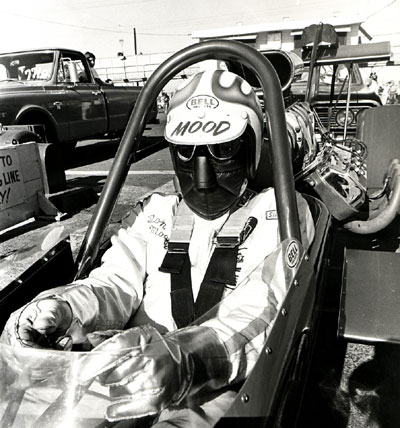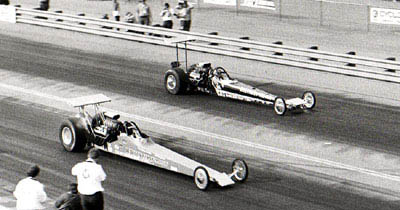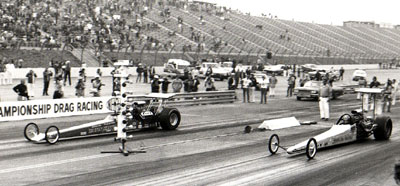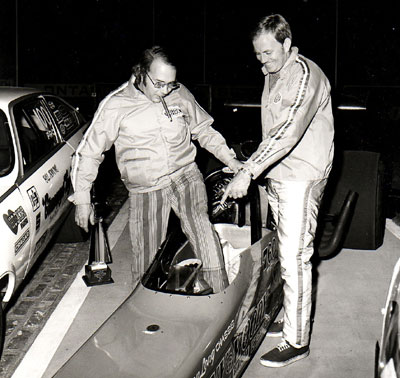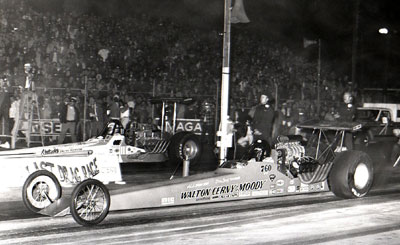

In the Mood
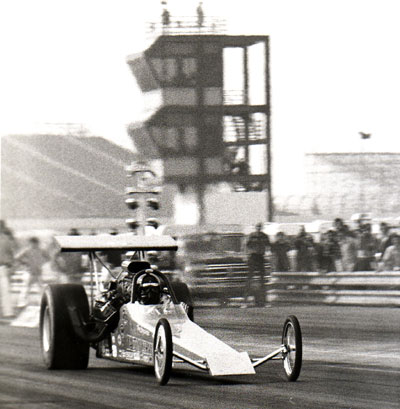 |
|
|
|
|
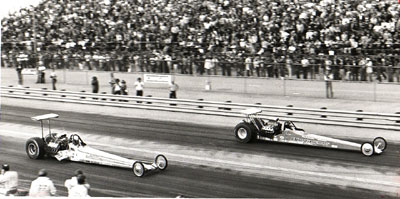 |
|
|
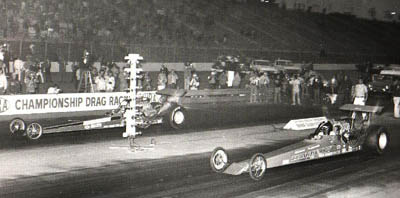 |
|
|
In the process of compiling the biographies for the more than 100 cars in the seven polls in our Favorite Race Car Ever balloting, I’m clearly my own worst enemy. Having easy access to the nearly 2,300 issues of National DRAGSTER that have been printed plus a handful of indispensable research tomes, I find that I’m easily sidetracked into searching out the hither and yon of our sport. The graphic for this column on the home page of NHRA.com promises “the stories behind the stories,” and that’s what I try to accomplish with each entry. Most of you here already know the ABCs of the sport’s history – I’d wager that the knowledge and recall of readers of this column are in the top 10 percentile of drag racing history buffs – so I clearly can’t bamboozle you with mere retellings of something you already know.
So, while researching the Walton-Cerny-Moody Top Fueler for the poll in the column below this one (haven't voted yet? There's still time!) and the histrionics of the first five-second Top Fuel runs at the 1972 Supernationals at Ontario, I realized there was one important aspect of that race that had not been covered. We all know that Mike Snively won the race to the fives with a 5.974-second clocking in Jim Annin’s dragster in the semifinals and that Don Moody then won the final with a stupefying 5.91, but what I didn’t realize was how easily it could have been Moody who held that historic mantle the last 36 years.
The round before Snively’s historic barrier breaker, Moody’s Wes Cerny-tuned orange rocket ran 6.00 at 232 mph, and then, right before Snively’s run in the semi's, Moody ran 6.01 at only 202 mph. He literally twice was milliseconds away from quarter-mile immortality.
To be honest, I can't even recall ever seeing or reading any in-depth interviews or behind-the-scenes story about the race from Snively or Annin, and since sadly both are no longer with us, I guess I never will, but I was able to make contact with Moody, who has been living in Thailand the last 14 years, courtesy of his biggest fan, his daughter Darielle, keeper of the family scrapbook. She gave me her dad’s e-mail address but promised little else, warning that, with her old-school father, “You race or not ... you don't talk about it.”
Apparently, though, and luckily for all of us, the “mood” must have been right, because the former national event winner, now 67 years old with a sharp memory, obliged my requests for an interview to talk about that memorable weekend.
But first, let’s backtrack a little to put this all into context. As we all know, Don Garlits turned the Top Fuel world on its ear in 1971 with the first nationally successful rear-engine Top Fueler, and the benefits of the back-motor car were plainly evident. The low e.t. of 1970 was a 6.43 by Don Prudhomme’s front-engine car in winning in Indy, and a year later, “Big Daddy” ran 6.21 at the Big Go, a drop of more than two-tenths. As soon as the other smart teams got a handle on the new configuration, the e.t.s began to plummet.
Prudhomme’s rear-engine Yellow Feather (and John Wiebe’s slingshot) ran 6.17 at Lions to open 1972, Garlits went 6.15 in Gainesville in March, Clayton Harris 6.11 at Suffolk Dragway in Virginia in April, and Jerry “the King” Ruth found the 6.0s twice in Indy.
Carl Olson, whose Mile Kuhl-tuned dragster was one of the nation’s best and the 14th member of the Cragar Five-Second Club, explained that “the teams were coming to grips with these new, somewhat lighter (no front-end ballast required) chassis. There was also a big advance in the horsepower department with the advent of the Donovan 417 and Keith Black Hemi aluminum engines.”
Moody, general manager of Engle Cams, and Cerny, the shop foreman, had a rolling laboratory for their camshafts and took full advantage.
“We naturally had the opportunity to run any camshaft Wes wanted,” he said, “same as most of the Keith Black teams, including Jeb Allen, Kuhl & Olson, and John Wiebe -- they all had Engle cams. The best combination would win out, and valve timing and fuel delivery were very important. Most of the 426 KB teams ran the Engle KB-425 (FF-5 is what we called it) flat tappet profile, same as we had in the car at the Supernationals, though Wes would sometimes run a roller camshaft. I think the magic was in Jack Engle’s head; he came up with the rise and fall tables with the old slide rule.”
All of this newly brewed horsepower and lighter, more sophisticated cars set the stage for the race to the fives, and while the carrot was out there, it wasn’t in the forefront of the mind for many.
(Tommy Ivo is credited by some with the first five, having recorded a 5.97 at a match race in New Alexandria, Pa., in late October, about three weeks before the Ontario event, but it remains a controversial clocking; all of the other 15 members of the Cragar Five-Second Club recorded their numbers at either an NHRA national or divisional meet.)
“I don't remember giving it any thought,” recalled Moody. “At least Wes and I never talked about it. The barometric pressure was good that Sunday, and the traction was excellent; I understand NHRA had sprayed the surface for 1,000 feet.”
The qualifiers were crowded between the surprise polesitter, Colorado-based schoolteacher Ed Renck at 6.09 (who later had to withdraw from the event due to bearing problems), and the next year’s world champ, Ruth, who sat on the bump in No. 16 at 6.26; the slowest of the 32 cars on the grounds ran 6.40. Snively was second at 6.10, and Moody seventh with a 6.22 at just 190 mph.
Moody opened with a 6.20 to beat newly crowned world champ Jim Walther, who had claimed the title a few weeks earlier with his victory at the World Finals in Amarillo, Texas, then in round two, just after Vic Brown had stunned the fans with a 6.04 in the Creitz & Dill machine against Pat Dakin, Moody laid waste to Gary Beck’s 6.13 with the aforementioned 6.00 at 232.55.
“Between rounds, Wes had upped the blower boost, thus the 6-flat, but it was spinning the tires in the lights,” said Moody. “On the 6.01 run [in the semifinals, against Olson], I shut off early (we had the race won), [and because] we had just spun the tires through the lights, I didn't want to throw all the parts out.”
Without today’s modern data recorders or incremental timers on the track, it’s nigh impossible to predict what the car might have run, but it clearly would have been a five. Still, all these years later, Moody remains nonplussed about the lost opportunity or even losing the race to the fives when Snively followed on his heels with the 5.97, albeit in a losing run against Brown.
“Speculation being what it is, one could guess should I have run slightly farther before I lifted than I did it would have dipped into the fives,” he said. “I wasn't disappointed at all [about not being the first in the fives]. Snively and Annin had the same combination as us, a Keith Black engine and an Engle FF-5 camshaft.
“In the last round against Dill-Creitz & Brown, Wes said drive it all the way. So, I just let her sing ... hence the 5.91. Victor drew a red-light, but I had already passed him at the Tree.
“Yes, 1972 was a good year for drag racing. I was 32 years old,

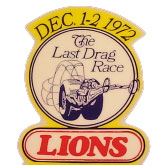 |
The 1972 season concluded memorably and a bit sadly Dec. 2 for Moody and Olson at the Last Drag Race at fabled Lions Drag Strip.
That final event was part drag race, part riot as fans overflowed the facility and overwhelmed the security and pretty much did whatever they pleased. Fans sat on the guardrails and torched anything that was flammable; it was a rather inglorious sendoff for a track that meant so much to so many.
There’s little doubt that every Top Fuel team in attendance wanted to have the last bragging rights at Lions, and with a $5,000 bounty offered by Cragar to the driver who could post Lions’ first five and the promise of Lions’ famous sea-breeze conditions, the teams planned to swing for the fences. Unfortunately, as Steve Alexander reported for Hot Rod magazine, “the gods wouldn't be good to the fans and racers that night. The dense ocean fog that usually rolled in to the strip at night was being held off by a mild Santa Ana wind blowing warm and lean air in from the desert.”
|
|
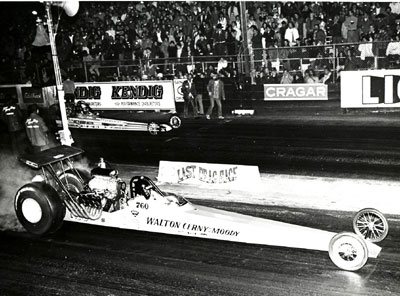 |
Moody qualified No. 1 with a 6.049 that gave the fans hope, and Olson’s now-Donovan-powered dragster was right there with a 6.092, followed by Keeling & Clayton shoe Rick Ramsey (6.11), Ruth (6.16), Dennis Baca (6.17), and James Warren (6.19).
“There will never be a place like Long Beach,” said Moody. “The atmospheric pressure and the traction in the evening was the best anywhere. The problem that night was tire shake; I had to lift each time just to get down the course. When the tires started to shake, it was like looking down eight racetracks (four in each eye); if my head would have touched the roll bar, it would have knocked me cold.”
Moody actually lost the first round to Gary Beck, 6.31 to 6.46, but got back in on the break rule after Beck’s Indy-winning dragster shelled the clutch in the lights. In round two, Moody blasted Baca, 6.15 to 6.39, and in the semifinals, held well past midnight, Moody thumped out a 6.029 to beat teenage sensation Jeb Allen’s 6.50 while Olson took down tire-smoking Snively with a 6.21.
The race coverage from the event reported that Moody and Cerny had irreparable wounded their KB in the semifinal, allowing Allen back in on the break rule to face – and lose to – Olson’s 6.20, but that was far from the whole story.
“The spectators at the end of the track and lining the push road were drinking beer,” recalled Moody. “When I would shut off early and still run 6.02 and 6.04, they would get angry and throw cans on the way back to the pits. Wes and I decided to put it in the trailer not knowing for sure that we could run a five-second pass with the tire shake. I didn't want to get hit with a half-empty beer can or bottle.
"Looking back at it, I probably should have tried it and outrun Kuhl & Olson in the process, and this is the first time I have ever heard of a $5,000 bonus. For $5,000, I would have run down an alley with the tire shake.”
Kuhl and Olson also battled tire shake – it broke their motor mount and a wing strut in the semifinals, leading Kuhl to fetch his always-handy roll of baling wire to improvise repairs – and the fans.
|
|
 |
“The fans were rowdy beyond control from about the second round on,” recalled Olson, “and there was plenty of trash both on the return road and on the track. Given the emotional importance of this event for me and Mike, we weren't about to let a little thing like the rowdiness or the trash keep us from running for the win. On one pass back up the return road, I remember running over a football that had gone astray from a pickup game in the field behind the return road. Fortunately, there was no serious damage to the car. The football, unfortunately, was trashed. I thought we were going to be attacked by the players whose game we'd obviously cut short.”
Olson had practically grown up at Lions, and winning its final event was meaningful, especially in light of their recent misfortune of crashing their first rear-engine car at the IHRA Nationals in Dallas.
“When we went to the line for the final, the scene was absolutely surreal. By now, all attempts to control the crowd had been abandoned. I honestly think the security staff took a look at what was happening and headed for the hills! There were hundreds of people in the staging area, and as has been mentioned before, spectators were actually sitting on the single Armco guardrail all the way down to the finish line. There were people where only the guardrail should have been, and I really didn't want to pick any of them off, so I stayed as close to the centerline as possible.
“I ran over several beer and wine bottles on the track, and I can vividly remember the crunching sensation as I hit ‘em. If I recall correctly, we ran a 6.20 in the final. Jeb was right behind in a very good race. We were both very proud of the fact that the last Top Fuel race at LADS had been a good one.
“I held my breath as the chute deployed and breathed a huge sigh of relief when the engine stayed put. Then, and only then, did I begin to appreciate the fact that I'd won the most important race of my life. Other races were more prestigious (Winternationals, Bakersfield, etc.), but this was definitely the sweetest victory of my drag racing career.
“The good news was that we'd won the race. The bad news was that Lions was gone forever, and with it a way of life I'd embraced since my youth. On that day, a lot of things changed for a lot of people, me included. To me, Lions was drag racing's Camelot. I've been to and raced at a lot of tracks around the world, but none had the magic that Lions did. Sad to say, but there will never be another place like Lions Drag Strip. It's just not possible in this day and age and never will be again.”

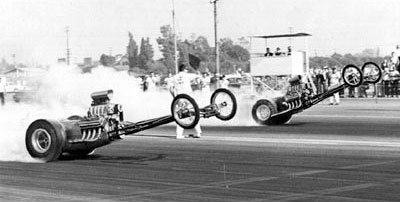 |
Those heady late-1972 runs weren’t the first time that Moody had wowed Southern Californians. A decade earlier, in early 1962, the Davis & Moody Top Gas dragster won Top Eliminator eight weeks in a row at Lions Drag Strip -- “the ‘meat grinder’ for drag racing, the best ticket in town,” said Moody.
Later that year, he and Carroll Davis put the 392 Keith Black Chrysler of "Doc" Magan’s Golden Thing drag boat into their car and ran the first seven-second pass at Pomona Raceway. “It was a Sunday race in November 1962,” he recalled. “We ran 7.99, then 7.96 in the last round; this was a big thing for me with Ivo & Zeuschel, Frank Cannon, Greer-Black & Prudhomme, Safford & Gaide, Ed Pink, Ewell-Stecker & Kamboor, Porter & Reis [in attendance]; this was a good day. We skinned the whole lot!”
Here's a famous shot of Moody and the Golden Thing AA/FD, far lane, in a wild, wheels-up duel with Norm Weekly and the Frantic Four A/FD at the 1963 Winternationals.

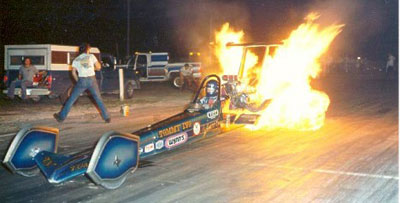 |
Speaking of '70s Top Fuelers, talented British artist Mark Gredzinski passed along this list of Top Fuel cars that had wheel pants at one point or another. I can’t verify the accuracy of about a third of this list simply because I’m not familiar with some of the cars, but it’s a cool list nonetheless: Lisa & Rossi (1973), Warren & Coburn, Mike Snively/Jim Annin, Jade Grenade, California Charger, Tommy Ivo (pictured), John Austin (Hot Tuna), Mark Howick, Pat Dakin/G.L. Rupp, Terry Capp (Wheeler Dealer), Don Garlits (1973 Winternationals), Bob Beaulieu (Eastern Raider), Dick LaHaie, Poncho Rendon, Tony Froome (Sundowner from England), Danny Ongais (Vel’s Parnelli Jones), Tony Nancy, Bob Williams, Barry Setzer, John Abbott, Vern Hagestad, Bob Holley (American Express), and Gary Dye.

 |
Okay, that should get you “in the Mood” for the rest of the 1970s Top Fuel balloting and whet your appetite for Monday’s introduction of the 1970s Funny Car poll. It’s going to be some ground-shaking fun.
Speaking of which, thanks for all the notes and concern following Tuesday’s little rumbler here in SoCal. I’m thinking you guys were more worried that the next column would be delayed rather than inquiring about my well-being, but we pulled through fine. It was a good little rock-and-roller that tumbled some of my hockey trophies off a bookshelf (unlike John Force’s keepsakes, none of mine were damaged), tipped over some autographed pucks on my window ledge, swung my 2008 Division 4 Super Stock/Stock Calendar off its pushpin, and partially unseated one of the air-conditioning vent covers (pictured) near Senior Editor Kevin McKenna’s desk, but nothing that really shook up our SoCal quake veterans. Following our well-practiced evacuation procedure – who remembers the bomb threat I wrote about here last year? – we calmly made our way out to the parking lot, and, after I did roll call, we all kinda looked at one another, shrugged, and headed back to our desks.
Just another day at work. Next up: a fiberglass forest of '70s Funny Cars!




















































